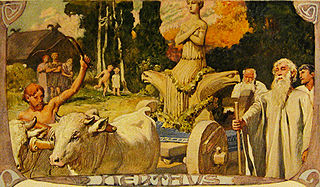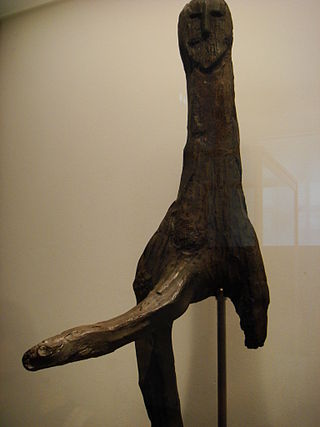
In Norse mythology, Ask and Embla —male and female respectively—were the first two humans, created by the gods. The pair are attested in both the Poetic Edda, compiled in the 13th century from earlier traditional sources, and the Prose Edda, written in the 13th century by Snorri Sturluson. In both sources, three gods, one of whom is Odin, find Ask and Embla and bestow upon them various corporeal and spiritual gifts. A number of theories have been proposed to explain the two figures, and there are occasional references to them in popular culture.

The Germanic peoples were historical groups of people that once occupied Northwestern and Central Europe and Scandinavia during antiquity and into the early Middle Ages. Since the 19th century, they have traditionally been defined by the use of ancient and early medieval Germanic languages and are thus equated at least approximately with Germanic-speaking peoples, although different academic disciplines have their own definitions of what makes someone or something "Germanic". The Romans named the area belonging to North-Central Europe in which Germanic peoples lived Germania, stretching East to West between the Vistula and Rhine rivers and north to south from Southern Scandinavia to the upper Danube. In discussions of the Roman period, the Germanic peoples are sometimes referred to as Germani or ancient Germans, although many scholars consider the second term problematic since it suggests identity with present-day Germans. The very concept of "Germanic peoples" has become the subject of controversy among contemporary scholars. Some scholars call for its total abandonment as a modern construct since lumping "Germanic peoples" together implies a common group identity for which there is little evidence. Other scholars have defended the term's continued use and argue that a common Germanic language allows one to speak of "Germanic peoples", regardless of whether these ancient and medieval peoples saw themselves as having a common identity.

A bog body is a human cadaver that has been naturally mummified in a peat bog. Such bodies, sometimes known as bog people, are both geographically and chronologically widespread, having been dated to between 8000 BCE and the Second World War. The unifying factor of the bog bodies is that they have been found in peat and are partially preserved; however, the actual levels of preservation vary widely from perfectly preserved to mere skeletons.
Below are notable events in archaeology that occurred in 1952.

In Germanic paganism, Nerthus is a goddess associated with a ceremonial wagon procession. Nerthus is attested by first century AD Roman historian Tacitus in his ethnographic work Germania.

Old Norse religion, also known as Norse paganism, is a branch of Germanic religion which developed during the Proto-Norse period, when the North Germanic peoples separated into a distinct branch of the Germanic peoples. It was replaced by Christianity and forgotten during the Christianisation of Scandinavia. Scholars reconstruct aspects of North Germanic Religion by historical linguistics, archaeology, toponymy, and records left by North Germanic peoples, such as runic inscriptions in the Younger Futhark, a distinctly North Germanic extension of the runic alphabet. Numerous Old Norse works dated to the 13th-century record Norse mythology, a component of North Germanic religion.

Germanic paganism or Germanic religion refers to the traditional, culturally significant religion of the Germanic peoples. With a chronological range of at least one thousand years in an area covering Scandinavia, the British Isles, modern Germany, and at times other parts of Europe, the beliefs and practices of Germanic paganism varied. Scholars typically assume some degree of continuity between Roman-era beliefs and those found in Norse paganism, as well as between Germanic religion and reconstructed Indo-European religion and post-conversion folklore, though the precise degree and details of this continuity are subjects of debate. Germanic religion was influenced by neighboring cultures, including that of the Celts, the Romans, and, later, by the Christian religion. Very few sources exist that were written by pagan adherents themselves; instead, most were written by outsiders and can thus present problems for reconstructing authentic Germanic beliefs and practices.

The Thorsberg moor near Süderbrarup in Anglia, Schleswig-Holstein, Germany, is a peat bog in which the Angles deposited votive offerings for approximately four centuries. It is the location of important Roman Iron Age finds, including early Elder Futhark runic inscriptions such as the Thorsberg chape, a Roman helmet, a shield buckle, and an early example of socks. The finds are of similar importance as the contemporaneous finds from Illerup and Vimose in Denmark.

The Haraldskær Woman is the name given to a bog body of a woman preserved in a bog in Jutland, Denmark, and dating from about 490 BC. Workers found the body in 1835 while excavating peat on the Haraldskær Estate. The anaerobic conditions and acids of the peat bog contributed to the body's excellent preservation. Not only was the intact skeleton found, but so were the skin and internal organs. Scientists settled disputes about the age and identity of this well preserved body in 1977, when radiocarbon dating determined conclusively that the woman's death occurred around the 5th century BC.

Windeby I is the name given to the bog body found preserved in a peat bog near Windeby, Northern Germany, in 1952. Until recently, the body was also called the Windeby Girl, since an archeologist believed it to be the body of a 14-year-old girl, because of its slight build. Prof. Heather Gill-Robinson, a Canadian anthropologist and pathologist, used DNA testing to show the body was actually that of a sixteen-year-old boy. The body has been radiocarbon-dated to between 41 BC and 118 AD.
Norse religious worship is the traditional religious rituals practiced by Norse pagans in Scandinavia in pre-Christian times. Norse religion was a folk religion, and its main purpose was the survival and regeneration of society. Therefore, the faith was decentralized and tied to the village and the family, although evidence exists of great national religious festivals. The leaders managed the faith on behalf of society; on a local level, the leader would have been the head of the family, and nationwide, the leader was the king. Pre-Christian Scandinavians had no word for religion in a modern sense. The closest counterpart is the word siðr, meaning custom. This meant that Christianity, during the conversion period, was referred to as nýr siðr while paganism was called forn siðr. The center of gravity of pre-Christian religion lay in religious practice – sacred acts, rituals and worship of the gods.

Osterby Man or the Osterby Head is a bog body of which only the skull and hair survived. It was discovered in 1948 by peat cutters to the southeast of Osterby, Germany. The hair is tied in a Suebian knot. The head is at the State Archaeological Museum at Gottorf Castle in Schleswig, Schleswig-Holstein.

Norse, Nordic, or Scandinavian mythology is the body of myths belonging to the North Germanic peoples, stemming from Old Norse religion and continuing after the Christianization of Scandinavia, and into the Nordic folklore of the modern period. The northernmost extension of Germanic mythology and stemming from Proto-Germanic folklore, Norse mythology consists of tales of various deities, beings, and heroes derived from numerous sources from both before and after the pagan period, including medieval manuscripts, archaeological representations, and folk tradition. The source texts mention numerous gods such as the thunder-god Thor, the raven-flanked god Odin, the goddess Freyja, and numerous other deities.
Damendorf Man is a German bog body discovered in 1900 in the See Moor at the village Damendorf in Schleswig-Holstein, Germany.

The Broddenbjerg idol is a wooden ithyphallic figure found in a bog at Broddenbjerg, near Viborg, Denmark and now in the National Museum of Denmark in Copenhagen. It is dated to approximately 535–520 BCE.

Anthropomorphic wooden cult figurines, sometimes called pole gods, have been found at many archaeological sites in Central and Northern Europe. They are generally interpreted as cult images, in some cases presumably depicting deities, sometimes with either a votive or an apotropaic (protective) function. Many have been preserved in peat bogs. The majority are more or less crudely worked poles or forked sticks; some take the form of carved planks. They have been dated to periods from the Mesolithic to the Early Middle Ages, including the Roman Era and the Migration Age. The majority have been found in areas of Germanic settlement, but some are from areas of Celtic settlement and from the later part of the date range, Slavic settlement. A typology has been developed based on the large number found at Oberdorla, Thuringia, at a sacrificial bog which is now the Opfermoor Vogtei open-air museum.
Karl Schlabow was a German archaeologist, museum director and conservator with specialisations in textiles and in restoration of bog bodies. He founded the Neumünster Textile Museum. Since his death, his restorations have been called into question as overly aggressive.
The Ralaghan idol, also known as the "Ralaghan figure", is a late Bronze Age anthropomorphic, carved wooden figure found in a bog in the townland of Ralaghan, County Cavan, Ireland. It is held by the National Museum of Ireland.

A prominent position was held by wetlands and islands in Germanic paganism, as in other pagan European cultures, featuring as sites of religious practice and belief from the Nordic Bronze Age until the Christianisation of the Germanic peoples.













